
- Home
- Memories
- Scrapbook ▽
- Topics ▽
- People ▽
- Events
- Photos
- Site Map
- Timeline
Click on a picture to enlarge
Also see History of the RAMM
RAMM 1979
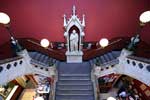 The grand staircase with the statue of
Prince Albert in pride of place. Originally built as a memorial to
Prince Albert, the museum has been a centre for education in Exeter
since 1869. Various plaques and busts to eminent Exeter worthies, who
promoted the museum, were on display on the walls of the entrance and
landing area.
The grand staircase with the statue of
Prince Albert in pride of place. Originally built as a memorial to
Prince Albert, the museum has been a centre for education in Exeter
since 1869. Various plaques and busts to eminent Exeter worthies, who
promoted the museum, were on display on the walls of the entrance and
landing area.
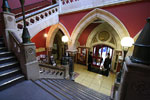 A doorman shows a visitors out of the
museum during the last week.
A doorman shows a visitors out of the
museum during the last week.

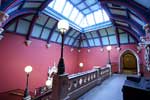 The dark red walls and blue paintwork is
a rich combination of colour in the landing area. It will be
interesting to see if this wonderful entrance space is retained in the
21st century museum.
The dark red walls and blue paintwork is
a rich combination of colour in the landing area. It will be
interesting to see if this wonderful entrance space is retained in the
21st century museum.
 The Sladen Gallery was a celebration
of Victorian Britain's thirst for maritime, scientific expedition.
Preserved creatures from the oceans of the world were on display; many
were collected by HMS Challenger during 1872, when she set sail for a
68,000 mile journey around the world with a team of scientists led by
Professor Wyville Thomson. The expedition trawled starfish up from
Sydney Harbour, jellyfish from a thousand fathoms in the Pacific and
specimens from Japan, Hawaii and Patagonia. Walter Percy Sladen, a
gentleman biologist, owned Northbrook House at Countess Wear. He
classified many of Challenger's starfish, and was the eminent expert in
his field. I hope the museum
integrates the story of the Challenger into the display of this
collection when they re-open in 2010.
The Sladen Gallery was a celebration
of Victorian Britain's thirst for maritime, scientific expedition.
Preserved creatures from the oceans of the world were on display; many
were collected by HMS Challenger during 1872, when she set sail for a
68,000 mile journey around the world with a team of scientists led by
Professor Wyville Thomson. The expedition trawled starfish up from
Sydney Harbour, jellyfish from a thousand fathoms in the Pacific and
specimens from Japan, Hawaii and Patagonia. Walter Percy Sladen, a
gentleman biologist, owned Northbrook House at Countess Wear. He
classified many of Challenger's starfish, and was the eminent expert in
his field. I hope the museum
integrates the story of the Challenger into the display of this
collection when they re-open in 2010.

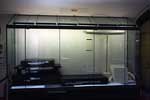 When
I visited the museum to take these photographs on the 29th November,
work was well advanced at emptying the displays and storing the
exhibits - this is the Islam glass case emptied of its artefacts.
When
I visited the museum to take these photographs on the 29th November,
work was well advanced at emptying the displays and storing the
exhibits - this is the Islam glass case emptied of its artefacts.
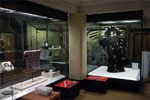 Another
area, the World Culture gallery, with some thin displays, as the staff
have removed and stored many exhibits. A costume and head dress from a
mysterious and exotic place somewhere in the tropics, that can be
reached in a few hours by Airbus is still on show.
Another
area, the World Culture gallery, with some thin displays, as the staff
have removed and stored many exhibits. A costume and head dress from a
mysterious and exotic place somewhere in the tropics, that can be
reached in a few hours by Airbus is still on show.

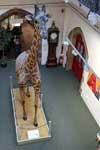 A photo essay of the RAMM would not be
complete without the old favourite, Gerald the Giraffe. Within days of
the final closing, Gerald was supported with packing and carefully
tipped over in preparation for moving from his gallery.
A photo essay of the RAMM would not be
complete without the old favourite, Gerald the Giraffe. Within days of
the final closing, Gerald was supported with packing and carefully
tipped over in preparation for moving from his gallery.
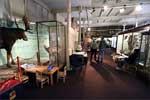 A view
down through the Natural History gallery - visitors were still browsing
the many exhibits before final closing on Saturday 1st December 2007.
A view
down through the Natural History gallery - visitors were still browsing
the many exhibits before final closing on Saturday 1st December 2007.

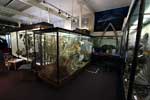 If
my memory serves me correctly this is the tiger shot by King George V.
A favourite with children, it is one of the stars of the Natural
History gallery.
If
my memory serves me correctly this is the tiger shot by King George V.
A favourite with children, it is one of the stars of the Natural
History gallery.
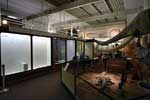
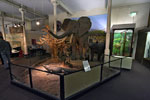 In the Natural History gallery the
large African tableau was still in place - an evocative little
grouping that is as far from the reality of African wildlife as Prince
Albert was from being a mill worker.
In the Natural History gallery the
large African tableau was still in place - an evocative little
grouping that is as far from the reality of African wildlife as Prince
Albert was from being a mill worker.

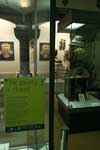 A This
gallery is closed poster on a glass cabinet warns off the
visitor from this section of the World Culture gallery.
A This
gallery is closed poster on a glass cabinet warns off the
visitor from this section of the World Culture gallery.
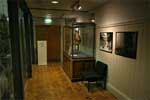 One of the
small corridors with a large glass walled storage area (at least it
always seemed to be used for storage) and the odd photograph and
isolated glass cabinet.
One of the
small corridors with a large glass walled storage area (at least it
always seemed to be used for storage) and the odd photograph and
isolated glass cabinet.
│ Top of Page │